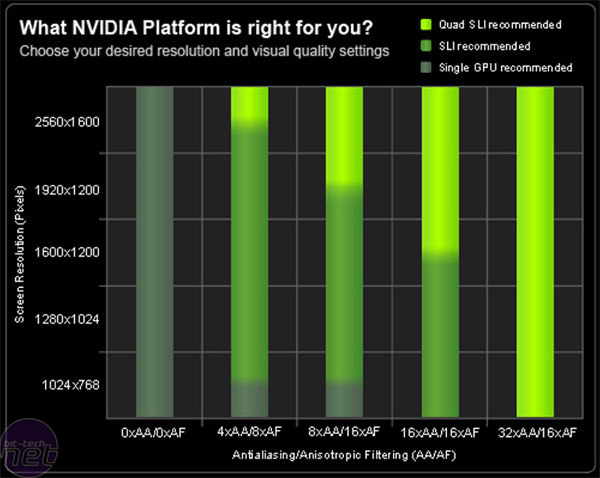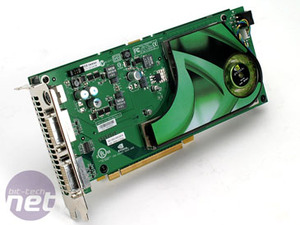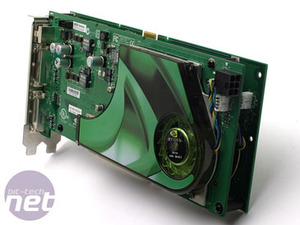Earlier this year, we had the chance to have a look at the first implementation of NVIDIA's Quad SLI technology, which had started shipping to consumers in pre-built systems from authorised system builders.
To be frank, there were a number of bugs that prevented Quad SLI from being a success at that time and we were left a little disappointed because the product had been hyped so much by NVIDIA's marketing team.
Since then, NVIDIA has been working incredibly hard on the drivers front, and it also launched a more consumer-friendly version of its dual-GPU video card that comes under the guise of GeForce 7950 GX2.
Over the last couple of weeks, we have had the chance to build our own Quad SLI system, based on Intel's recently-released Core 2 Extreme X6800 processor, an nForce4 SLI x16 Intel Edition motherboard and a pair of XFX GeForce 7950 GX2's.
 NVIDIA believes that gamers who game without anti-aliasing and anisotropic filtering enabled will not benefit from SLI, nevermind Quad SLI. However, the table seems to forget about HDR. Currently, it is not possible to play games with High Dynamic Range lighting (HDR) and anti-aliasing enabled on NVIDIA hardware if the developer has used an FP16 frame buffer to create the HDR effects.
NVIDIA believes that gamers who game without anti-aliasing and anisotropic filtering enabled will not benefit from SLI, nevermind Quad SLI. However, the table seems to forget about HDR. Currently, it is not possible to play games with High Dynamic Range lighting (HDR) and anti-aliasing enabled on NVIDIA hardware if the developer has used an FP16 frame buffer to create the HDR effects.
Of course, there are games that use a fixed range of colour values to emulate similar High-Dynamic Range lighting effects - the best example is in Valve's Source engine - but ultimately this is not as effective as a well-implemented FP16 method. NVIDIA says that you will need to utilise anti-aliasing to benefit from Quad at any resolution. This means that you're going to have to turn off HDR in games where it's impossible to enable both HDR and AA on NVIDIA's current hardware - we will have a look at this over the course of this article.
To be frank, there were a number of bugs that prevented Quad SLI from being a success at that time and we were left a little disappointed because the product had been hyped so much by NVIDIA's marketing team.
Since then, NVIDIA has been working incredibly hard on the drivers front, and it also launched a more consumer-friendly version of its dual-GPU video card that comes under the guise of GeForce 7950 GX2.
Over the last couple of weeks, we have had the chance to build our own Quad SLI system, based on Intel's recently-released Core 2 Extreme X6800 processor, an nForce4 SLI x16 Intel Edition motherboard and a pair of XFX GeForce 7950 GX2's.
Who benefits from Quad SLI?
Before we get on to taking you through building our own Quad SLI system and evaluating its performance, there are a few things that we need to cover in order to give you a better idea of where NVIDIA is positioning Quad SLI. We will also recap how Quad SLI works, too. If you haven't read our previous articles discussing NVIDIA's Quad SLI technology, we recommend that you give them a read in order to bring you up to where we are now:- Review: Quad SLI: GeForce 7900 GX2
- Dell and NVIDIA showcase first Quad SLI system
- Dell Quad SLI spy shots
- Quad SLI drivers 'at least two months away'
- Quad SLI is released to the masses

Of course, there are games that use a fixed range of colour values to emulate similar High-Dynamic Range lighting effects - the best example is in Valve's Source engine - but ultimately this is not as effective as a well-implemented FP16 method. NVIDIA says that you will need to utilise anti-aliasing to benefit from Quad at any resolution. This means that you're going to have to turn off HDR in games where it's impossible to enable both HDR and AA on NVIDIA's current hardware - we will have a look at this over the course of this article.

MSI MPG Velox 100R Chassis Review
October 14 2021 | 15:04











Want to comment? Please log in.